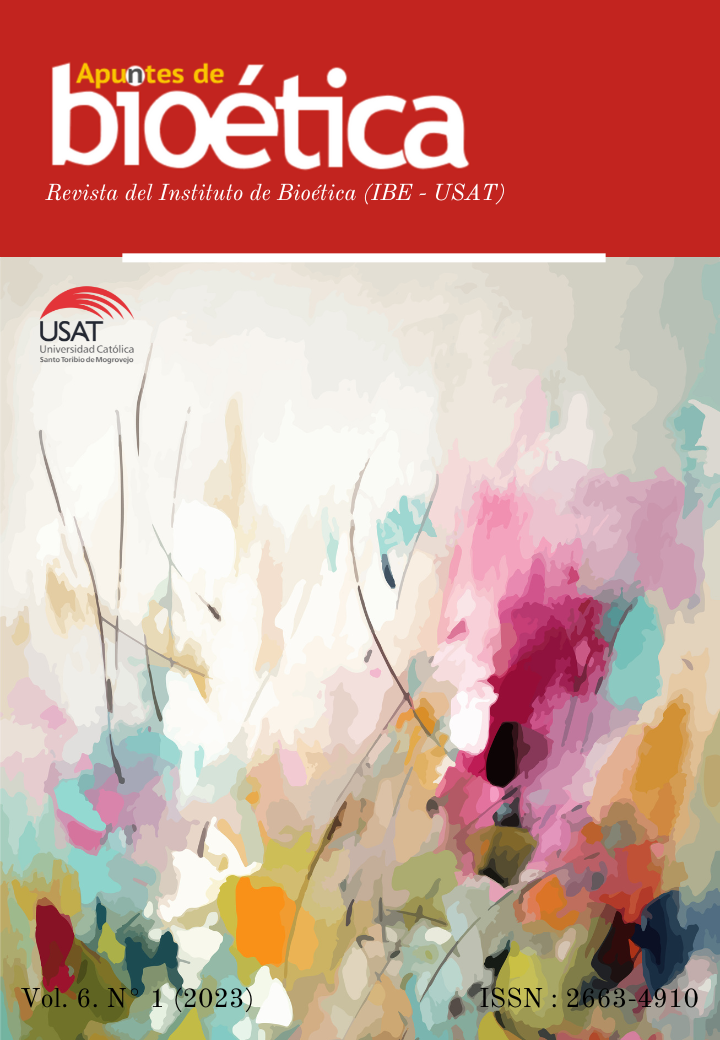Worldviews in Bioethics
interpretation of pain and suffering
Abstract
Problem statement: Pain is an integral part of the human experience. Therefore, it is important to analyze from Bioethics and its currents of thought the approach to this reality. Objectives: Analyze the phenomenon of pain and suffering based on the different worldviews of Bioethical thought. Materials and Methods: A bibliographic search was carried out from August 2021 to March 2022 using the following search engines: PubMed, EBSCO Host, Web of Science and Scielo. As inclusion criteria: articles that presented a bioethical analysis related to pain management were chosen. As exclusion criteria, all those articles that presented aspects related to pain management or bioethical analysis in an unrelated manner were discarded. Results: The interpretation of pain and its meaning from the different worldviews: liberalism, sociobiologism, utilitarianism and bioethical personalism is crucial, since it manifests a convergent problem, and allows a comprehensive approach to aspects of life experience. Pain and suffering are realities that often confront the person in search of their meaning in life. Conclusions: The differences between the currents of thought highlight how each of these worldviews seeks to understand how the person benefits. It is the duty of Bioethics to establish a field of dialogue, thus allowing a unified construction of society where the pertinent methodologies are systematically established to defend and promote the value of the human person.
Downloads
References
BBC Mundo. (2017). La enorme brecha entre la epidemia de abuso de opioides en Estados Unidos y la escasez en muchos otros países. . Obtenido de https://www.bbc.com/mundo/noticias-41696347
Beauchamp, T., & Childress, J. (2019). Principles of Biomedical Ethics: Marking Its Fortieth Anniversary. Am J Bioeth, 19(11), 9-12. doi:10.1080/15265161.2019.1665402
Bhadelia, A., De Lima, L., Arreola-Ornelas, H., Kwete, X., Rodriguez, N., & Knaul, F. (2019). Solving the Global Crisis in Access to Pain Relief: Lessons From Country Actions. Am J Public Health, 109(1), 58-60. doi:10.2105/AJPH.2018.304769
Black, E., Khor, K. E., & Demirkol, A. (2020). Responsible Prescribing of Opioids for Chronic Non-Cancer Pain: A Scoping Review. Pharmacy (Basel), 8(3), 150. doi:10.3390/pharmacy8030150
Brennan, F., Lohman, D., & Gwyther, L. (2019). Access to Pain Management as a Human Right. Am J Public Health, 109(1), 61–65. doi:10.2105/AJPH.2018.304743
Buber, M. (1967). ¿Qué es el Hombre? FCE.
Burgos, J. (2010). Antropología Breve. Ediciones Palabra.
Cerdio Domínguez, D. (2022). El manejo del dolor crónico -no oncológico-: un reto bioético emergente. Medicina y Ética, 505-525.
Charlesworth, M. (1996). La bioética en una sociedad libera. Cambridge University Press.
CONBIOÉTICA. (2015). Comisión Nacional Mexicana de Bioética. Obtenido de CONBIOÉTICA.
Congregación para la Doctrina de la Fe. (2020). Samaritanus Bonus. bollettino Sala Stampa della Santa Sede.
Covarrubias , A., Otero, M., Templos, L., & Soto, E. (2019). Antecedentes de la medicina paliativa en México: educación continua en cuidados paliativos. Revista Mexicana de Anestesiología, 42(2), 122-128.
Crofford, L. (2015). Chronic Pain: Where the Body Meets the Brain. Trans Am Clin Climatol Assoc, 167-183.
Dayer, L., Painter, J., McCain, K., King, J., Cullen, J., & Foster, H. (2019). A recent history of opioid use in the US: Three decades of change. Subst Use Misuse, 54(2), 331-339. doi:10.1080/10826084.2018.1517175
del Río, I., & Palma, A. (2007). Cuidados Paliativos: Historia y Desarrollo. Boletín Escuela de Medicina UC, 32(1), 16-22.
Domenichiello, A., & Ramsden, C. (2019). The silent epidemic of chronic pain in older adults. Prog Neuropsychopharmacol Biol Psychiatry, 284-290.
Edris , N., Schmucker, C., Nagavci, B., Motschall, E., Nitschke, K., Schulte, E., . . . Meerpohl, J. (2022). Efficacy and safety of strong opioids for chronic noncancer pain and chronic low back pain: a systematic review and meta-analyses. Pain, 63(4), 610-636. doi:0.1097/j.pain.0000000000002423
Emmerich, N. (2015). What is Bioethics? Medicine, Health Care and Philosophy, 437-441. doi:https://doi.org/10.1007/s11019-015-9628-7
Engelhardt, H. (1992). Bioethics and Secular Humanism. SCM Press.
Ferreira Souza, L., da Costa Pessoa, A., Alves Barbosa, M., & Varanda Pereira, L. (2013). [The bioethical principlism model applied in pain management]. Rev Gaucha Enferm, 34(1), 187-195. doi:10.1590/s1983-14472013000100024
Fuster, I. (2004). Perspectiva Antropológica del Sufrimiento. Espíritu: cuadernos del Instituto Filosófico de Balmesiana, 263-277.
Garcia, L., Fernandes, M., Moreno, J., & Goldim, J. (2019). Mapping Bioethics in Latin America: History, Theoretical Models, and Scientific Output. J Bioeth Inq, 16(3), 323-331. doi:10.1007/s11673-019-09903-7
García-Andreu, J. (2017). Manejo básico del dolor agudo y crónico. Anestesia en México, 77-85.
Gevaert, J. (2001). El problema del hombre. Sigueme.
Giordano, J., & Schatman, M. (2008). A crisis in chronic pain care: an ethical analysis. Part three: Toward an integrative, multi-disciplinary pain medicine built around the needs of the patient. Pain Physician, 11(6), 775-784.
Giordano, J., & Schatman, M. (2008). A crisis in chronic pain care: an ethical analysis. Part two: proposed structure and function of an ethics of pain medicine. Pain Physician, 11(5), 589-595.
Giordano, J., & Schatman, M. E. (2008). An ethical analysis of crisis in chronic pain care: facts, issues and problems in pain medicine, part I. Pain Physician, 11(4), 483-490.
Guerra López, R. (2013). Bioethics and rationality. Personalism at the service of expanding the horizon of reason at the foundation of bioethics. Cuadernos de bioetica, 24(80), 39-48.
Health NCfCaI. (2018). Chronic Pain: What You Need To Know. Obtenido de https://www.nccih.nih.gov/health/chronic-pain-what-you-need-to-know
Ibarra, E. (2006). Una Nueva Definición de Dolor. Un Imperativo en Nuestros Días. Revista de la Sociedad Española del Dolor, 13, 65-72.
Jennings, N., Chambaere, K., Macpherson, C., Deliens, L., & Cohen, J. (2018). Principales temas, obstáculos y soluciones en relación con los cuidados paliativos y al final de la vida en el Caribe de habla inglesa: examen sistemático exploratorio. Rev Panam Salud Publica, e15. doi:https://doi.org/10.26633/RPSP.2018.15
Juan Pablo II. (1995). Carta Encíclica: Evangelium Vitae.
Juan Pablo II. (1995). Salvifici Doloris.
Kalkach, M., & Carrilo, J. (2020). Neuroética (1 ed.). Manual Moderno.
Knaul, F. (2021). Disparities and crisis: access to opioid medicines in Mexico. Lancet Public Health, e83-e84. doi:10.1016/S2468-2667(21)00009-8
Kohrt , B., Griffith, J., & Patel, V. (2018). Chronic pain and mental health: integrated solutions for global problems. Pain, S85-S89. doi:10.1097/j.pain.0000000000001296
Kuthy Porter, J., Villalobos, J. d., Martínez, O., & Tarasco, M. (2014). Introducción a la Bioética (IV ed.). Universidad Anáhuac México.
Ortiz Millán, G. (2014). La dignidad, entre el escepticismo y el entusiasmo. Instituto de Investigaciones Filosóficas, 1-16.
Pastor, L. (2013). [From virtue bioethics to bioethics personalistic: is integration possible?]. Cuad Bioet, 24(80), 49-56.
Pio XII. (1952). Los límites morales de los métodos médicos.
Raja, S., Carr, D., Cohen, M., Finnerup, N., Flor, H., Gibson, S., . . . Vader, K. (2020). The revised International Association for the Study of Pain definition of pain: concepts, challenges, and compromises. Pain, 161(9), 1976-1982. doi:10.1097/j.pain.0000000000001939
Rieder, T. (2019). Opioids and Ethics: Is Opioid-Free the Only Responsible Arthroplasty? HSS J., 15(1), 12–16. doi:10.1007/s11420-018-9651-3
Sallnow, L., Smith , R., Ahmedzai , S., Bhadelia, A., Chamberlain , C., Cong, Y., . . . et all. (2022). Report of the Lancet Commission on the Value of Death: bringing death back into life. Lancet.
Sgreccia, E. (1996). Manual de Bioética. Ed. Diana.
Sgreccia, E. (1997). La persona y el respeto por la vida humana.
Sgreccia, E. (2013). Persona humana y Personalismo. Cuadernos de Bioética, XXIV(1), 115-123.
Singer, P. (1995). Ética Práctica. Cambridge University Press.
Smith, B., Fors, E., Korwisi, B., Barke, A., & Cameron, P. (2019). The IASP classification of chronic pain for ICD-11: applicability in primary care. Pain, 160(1), 83-87.
Spaemann, R. (1992). ¿Todos los hombres son personas? En Bioética: consideraciones filosófico-teológicas sobre un tema actual. Rialp.
Tarasco, M. (1994). Tendencias y corrientes filosóficas en Bioética. Medicina y Ética, 335-348.
Wang, S. (2019). Historical Review: Opiate Addiction and Opioid Receptors. Cell Transplant, 28(3), 233-238. doi:10.1177/0963689718811060
Wilson. (2013). What can history do for bioethics? Bioethics, 27(4), 215-223.
Wilson. (2014). El sentido de la existencia humana. Editorial Gedisa.
Copyright (c) 2023 David Cerdio-Domínguez, María-Elizabeth De los Ríos-Uriarte, Elvira García-Llaca (Autor/a)

This work is licensed under a Creative Commons Attribution 4.0 International License.
The authors retain copyright.
This work is under international license Creative Commons Attribution 4.0.
The articles published by the scientific journal "Notes on Bioethics" of the Universidad Catolica Santo Toribio de Mogrovejo, Chiclayo Peru, can be shared through the international public license Creative Commons Attribution CC BY 4.0
























 LIBRARY USAT
LIBRARY USAT